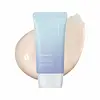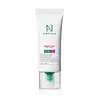What's inside
What's inside
 Key Ingredients
Key Ingredients

 Benefits
Benefits

 Concerns
Concerns

 Ingredients Side-by-side
Ingredients Side-by-side

Water
Skin ConditioningDibutyl Adipate
EmollientTitanium Dioxide
Cosmetic ColorantDiethylamino Hydroxybenzoyl Hexyl Benzoate
UV FilterPhenyl Trimethicone
Skin ConditioningOctyldodecanol
EmollientHydrogenated Polyisobutene
EmollientButylene Glycol
HumectantPropanediol
SolventGlycerin
HumectantLauryl PEG-10 Tris(Trimethylsiloxy)Silylethyl Dimethicone
EmulsifyingNiacinamide
SmoothingEthylhexyl Triazone
UV AbsorberSodium Chloride
MaskingIsododecane
EmollientAluminum Hydroxide
EmollientStearic Acid
Cleansing1,2-Hexanediol
Skin ConditioningBis-Ethylhexyloxyphenol Methoxyphenyl Triazine
Skin ConditioningTrimethylsiloxysilicate
EmollientRosa Damascena Flower Water
MaskingHydrolyzed Sodium Hyaluronate
Skin ConditioningSodium Hyaluronate
HumectantPrunus Serrulata Flower Extract
Skin ConditioningRosa Hybrid Flower Extract
Skin ConditioningSaussurea Involucrata Extract
HumectantNymphaea Alba Flower Extract
Skin ConditioningNelumbium Speciosum Flower Extract
Skin ConditioningChamomilla Recutita Flower Extract
MaskingCalendula Officinalis Extract
Skin ConditioningCamellia Japonica Flower Extract
EmollientHyaluronic Acid
HumectantHydroxypropyltrimonium Hyaluronate
Hydrolyzed Hyaluronic Acid
HumectantPotassium Hyaluronate
Skin ConditioningSodium Hyaluronate Crosspolymer
HumectantSodium Acetylated Hyaluronate
HumectantCaprylyl Methicone
Skin ConditioningPolyglyceryl-2 Isostearate
EmulsifyingDisteardimonium Hectorite
StabilisingCoco-Caprylate/Caprate
EmollientIsotridecyl Isononanoate
EmollientPolyglyceryl-6 Polyricinoleate
EmulsifyingSorbitan Isostearate
EmulsifyingCI 77492
Cosmetic ColorantPropylene Carbonate
SolventEthylhexylglycerin
Skin ConditioningTriethoxycaprylylsilane
CI 77491
Cosmetic ColorantPolyglyceryl-6 Polyhydroxystearate
EmulsifyingPolyglycerin-6
HumectantPEG-12 Dimethicone/PPG-20 Crosspolymer
PEG-10
HumectantWater, Dibutyl Adipate, Titanium Dioxide, Diethylamino Hydroxybenzoyl Hexyl Benzoate, Phenyl Trimethicone, Octyldodecanol, Hydrogenated Polyisobutene, Butylene Glycol, Propanediol, Glycerin, Lauryl PEG-10 Tris(Trimethylsiloxy)Silylethyl Dimethicone, Niacinamide, Ethylhexyl Triazone, Sodium Chloride, Isododecane, Aluminum Hydroxide, Stearic Acid, 1,2-Hexanediol, Bis-Ethylhexyloxyphenol Methoxyphenyl Triazine, Trimethylsiloxysilicate, Rosa Damascena Flower Water, Hydrolyzed Sodium Hyaluronate, Sodium Hyaluronate, Prunus Serrulata Flower Extract, Rosa Hybrid Flower Extract, Saussurea Involucrata Extract, Nymphaea Alba Flower Extract, Nelumbium Speciosum Flower Extract, Chamomilla Recutita Flower Extract, Calendula Officinalis Extract, Camellia Japonica Flower Extract, Hyaluronic Acid, Hydroxypropyltrimonium Hyaluronate, Hydrolyzed Hyaluronic Acid, Potassium Hyaluronate, Sodium Hyaluronate Crosspolymer, Sodium Acetylated Hyaluronate, Caprylyl Methicone, Polyglyceryl-2 Isostearate, Disteardimonium Hectorite, Coco-Caprylate/Caprate, Isotridecyl Isononanoate, Polyglyceryl-6 Polyricinoleate, Sorbitan Isostearate, CI 77492, Propylene Carbonate, Ethylhexylglycerin, Triethoxycaprylylsilane, CI 77491, Polyglyceryl-6 Polyhydroxystearate, Polyglycerin-6, PEG-12 Dimethicone/PPG-20 Crosspolymer, PEG-10
Water
Skin ConditioningC12-15 Alkyl Benzoate
AntimicrobialTitanium Dioxide
Cosmetic ColorantButylene Glycol
HumectantButyloctyl Salicylate
Skin ConditioningPolymethylsilsesquioxane
Glycerin
HumectantCaprylyl Methicone
Skin Conditioning1,2-Hexanediol
Skin ConditioningAluminum Stearate
Cosmetic ColorantPolyhydroxystearic Acid
EmulsifyingDipropylene Glycol
HumectantPentylene Glycol
Skin ConditioningLavandula Hybrida Oil
EmollientCitrus Paradisi Peel Oil
MaskingRosmarinus Officinalis Leaf Oil
MaskingHelianthus Annuus Seed Oil
EmollientChamomilla Recutita Flower Oil
MaskingForsythia Suspensa Fruit Extract
AntioxidantAniba Rosaeodora Wood Oil
AstringentCaprylic Acid
CleansingAlumina
AbrasiveP-Cresol
AntimicrobialAmmonium Acryloyldimethyltaurate/Vp Copolymer
Polyacrylate Crosspolymer-6
Emulsion StabilisingSodium Stearoyl Glutamate
CleansingHydroxypropyl Methylcellulose Stearoxy Ether
Ethylhexylglycerin
Skin ConditioningStearic Acid
CleansingCeramide NP
Skin ConditioningAllantoin
Skin ConditioningWater, C12-15 Alkyl Benzoate, Titanium Dioxide, Butylene Glycol, Butyloctyl Salicylate, Polymethylsilsesquioxane, Glycerin, Caprylyl Methicone, 1,2-Hexanediol, Aluminum Stearate, Polyhydroxystearic Acid, Dipropylene Glycol, Pentylene Glycol, Lavandula Hybrida Oil, Citrus Paradisi Peel Oil, Rosmarinus Officinalis Leaf Oil, Helianthus Annuus Seed Oil, Chamomilla Recutita Flower Oil, Forsythia Suspensa Fruit Extract, Aniba Rosaeodora Wood Oil, Caprylic Acid, Alumina, P-Cresol, Ammonium Acryloyldimethyltaurate/Vp Copolymer, Polyacrylate Crosspolymer-6, Sodium Stearoyl Glutamate, Hydroxypropyl Methylcellulose Stearoxy Ether, Ethylhexylglycerin, Stearic Acid, Ceramide NP, Allantoin
 Reviews
Reviews

Ingredients Explained
These ingredients are found in both products.
Ingredients higher up in an ingredient list are typically present in a larger amount.
1,2-Hexanediol is a synthetic liquid and another multi-functional powerhouse.
It is a:
- Humectant, drawing moisture into the skin
- Emollient, helping to soften skin
- Solvent, dispersing and stabilizing formulas
- Preservative booster, enhancing the antimicrobial activity of other preservatives
Butylene Glycol (or BG) is used within cosmetic products for a few different reasons:
Overall, Butylene Glycol is a safe and well-rounded ingredient that works well with other ingredients.
Though this ingredient works well with most skin types, some people with sensitive skin may experience a reaction such as allergic rashes, closed comedones, or itchiness.
Learn more about Butylene GlycolCaprylyl Methicone is a type of silicone.
It helps soften and soothe the skin by creating a thin film on top. This film helps trap moisture, keeping your skin hydrated.
Ethylhexylglycerin (we can't pronounce this either) is commonly used as a preservative and skin softener. It is derived from glyceryl.
You might see Ethylhexylglycerin often paired with other preservatives such as phenoxyethanol. Ethylhexylglycerin has been found to increase the effectiveness of these other preservatives.
Glycerin is already naturally found in your skin. It helps moisturize and protect your skin.
A study from 2016 found glycerin to be more effective as a humectant than AHAs and hyaluronic acid.
As a humectant, it helps the skin stay hydrated by pulling moisture to your skin. The low molecular weight of glycerin allows it to pull moisture into the deeper layers of your skin.
Hydrated skin improves your skin barrier; Your skin barrier helps protect against irritants and bacteria.
Glycerin has also been found to have antimicrobial and antiviral properties. Due to these properties, glycerin is often used in wound and burn treatments.
In cosmetics, glycerin is usually derived from plants such as soybean or palm. However, it can also be sourced from animals, such as tallow or animal fat.
This ingredient is organic, colorless, odorless, and non-toxic.
Glycerin is the name for this ingredient in American English. British English uses Glycerol/Glycerine.
Learn more about GlycerinStearic Acid is a fatty acid. It is an emollient, emulsifier, and texture enhancer.
As an emollient, stearic acid helps soften skin. It aids the skin's protective barrier by preventing water loss. It also provides a gentle cleansing effect without stripping away natural oils.
Stearic acid may also be used to enhance the texture of products. It can add volume and stabilize ingredients such as water and oil. This can help water and oil ingredients from separating.
Sources of stearic acid include animal or vegetable fats/oils such as coconut or shea. It can be naturally found in butter, cocoa butter, shea butter, vegetable fats, and animal tallow.
This ingredient may not be Malassezia folliculitis, or fungal-acne safe.
Learn more about Stearic AcidTitanium dioxide is a mineral UV filter widely used in sunscreens and cosmetics.
It is one of only two UV filters officially classified as “mineral” by regulatory agencies, the other being zinc oxide.
Titanium dioxide provides broad-spectrum protection mostly in the UVB and UVAII range, with some protection in the UVAI range.
While its UVA protection isn’t as strong as zinc oxide’s, the difference is minor.
A common myth is that mineral UV filters reflect UV light. However, modern research shows titanium dioxide absorbs UV radiation like chemical filters (~95% absorption & 5% reflection).
Thanks to its non-irritating nature, titanium dioxide is suitable for sensitive, acne-prone, or redness-prone skin. It is unlikely to cause "eye sting" like other sunscreen ingredients.
A major drawback of this ingredient is its white cast and thick texture. This is why mineral sunscreens often leave a white cast and are less cosmetically elegant than chemical/hybrid sunscreens.
To improve white cast and spreadability, micronized or nano-sized titanium dioxide is often used.
There are ongoing concerns surrounding nano-titanium oxide's impact on marine ecosystems.
There is no conclusive evidence that any form of titanium oxide (or any other sunscreen ingredients) will cause harm to marine ecosystems or coral reefs. The science is still developing but many consumers are keeping a close eye on this issue.
Please note, many destinations have reef-safety sunscreen rules. For instance, the U.S. Virgin Islands advises all visitors to use non-nano mineral sunscreens.
Nano mineral sunscreens once raised safety concerns about absorption into skin.
Extensive research has shown that they do not penetrate healthy or damaged skin; they remain safely on the surface and the top layer of dead skin (stratum corneum).
You'll likely find titanium dioxide bundled with alumina, silica, or dimethicone. These ingredients help make titanium dioxide highly photostable; this prevents it from interacting with other formula components under UV light.
Learn more about Titanium DioxideWater. It's the most common cosmetic ingredient of all. You'll usually see it at the top of ingredient lists, meaning that it makes up the largest part of the product.
So why is it so popular? Water most often acts as a solvent - this means that it helps dissolve other ingredients into the formulation.
You'll also recognize water as that liquid we all need to stay alive. If you see this, drink a glass of water. Stay hydrated!
Learn more about Water